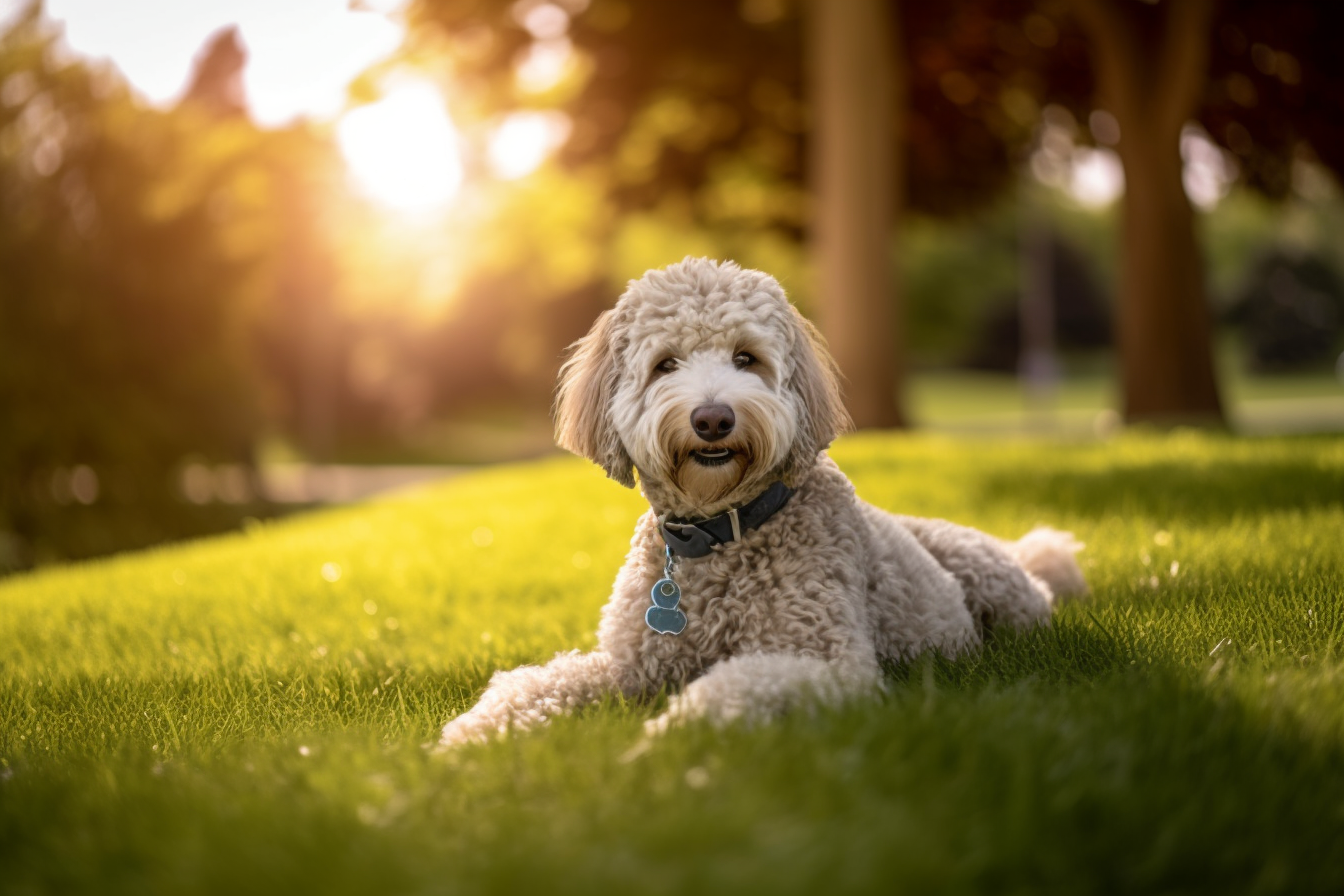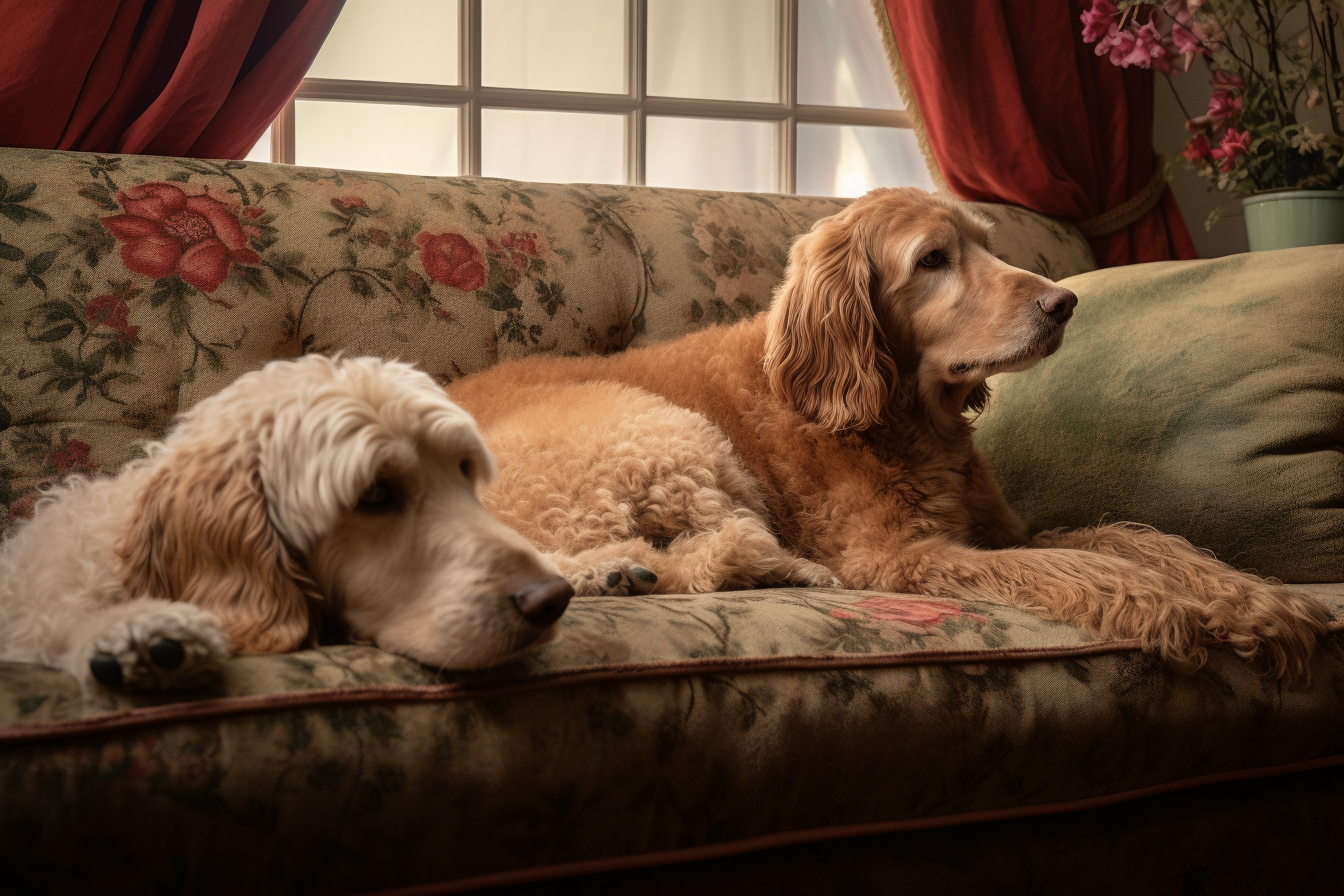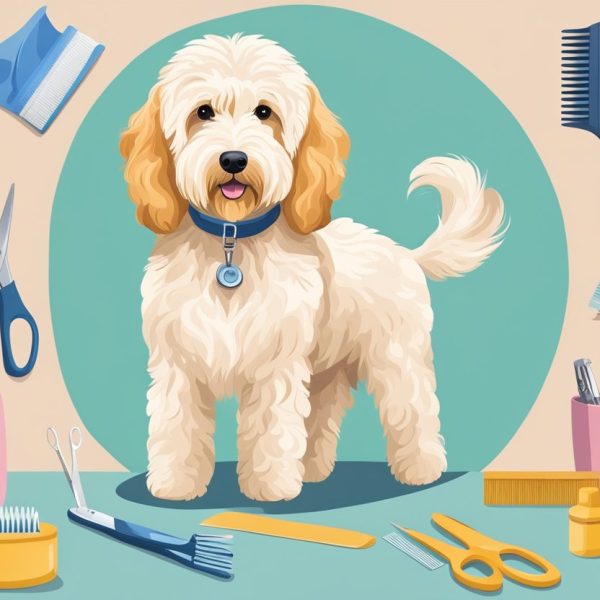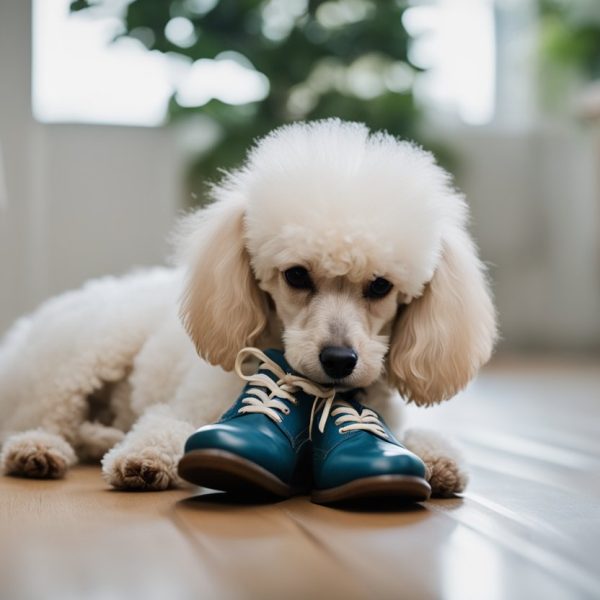
Introduction
Doodle dogs have taken the world by storm with their adorable appearances, friendly personalities, and hypoallergenic coats. These lovable hybrids, like Labradoodles, Goldendoodles, and other Poodle crosses, often have unique and beautiful coats that can be wavy, curly, or shaggy. As a doodle dog owner, you’ve likely marveled at your furry friend’s distinctive appearance, but you may also have realized that maintaining their coat is a considerable responsibility.
In this guide, we’ll explore the essentials of doodle dog coat care, providing you with the knowledge and tools to keep your doodle looking and feeling their best. In addition, we’ll delve into the different coat types, grooming essentials, and how to maintain your doodle’s overall health. So, let’s embark on this journey together and ensure your doodle’s coat remains a source of pride and joy for both of you!
Proper coat care is paramount for doodle dog owners to maintain their dog’s stunning appearance and ensure their overall well-being. A well-groomed coat helps prevent matting and tangling, leading to skin irritation, discomfort, and even infection if left unattended. Moreover, a healthy coat is an effective barrier against environmental factors, such as cold, heat, and moisture, protecting your doodle’s skin from harm.
By investing time and effort into regular grooming and coat maintenance, you’re not just preserving your doodle’s aesthetic appeal and contributing to their overall health and happiness. In addition, a well-groomed doodle is easier to handle and less prone to shedding, making them more enjoyable companions for you and your family. Furthermore, grooming sessions can be an excellent opportunity to bond with your doodle, strengthening your relationship with your furry friend.
Understanding Doodle Dog Coats
To provide the best care for your doodle’s coat, it’s crucial to understand the various coat types and the factors influencing their traits. With a solid grasp of what makes doodle dog coats unique, you’ll be better equipped to address your pet’s specific grooming needs.
A. Coat Types
Doodle dog coats come in three main types, each with its own distinct characteristics and care requirements:
- Wavy: Wavy coats are a common type among doodle dogs. They have a loose, flowing texture, with gentle waves instead of tight curls. This coat type may require slightly less maintenance than curly coats but still needs regular grooming to prevent matting and tangling.
- Curly: Curly coats are reminiscent of Poodle coats, featuring tight curls that are densely packed together. This coat type is more prone to matting and requires consistent grooming to keep it tangle-free and healthy. Curly coats are often considered more hypoallergenic, as they tend to shed less than other coat types.
- Shaggy: Shaggy coats have a more relaxed, tousled appearance, with longer hair that can sometimes form looser curls or waves. This coat type can be more challenging to maintain, as the long hair is more likely to mat and tangle. Regular grooming is essential to keep a shaggy coat manageable and healthy.
B. Factors Influencing Coat Traits
The appearance and texture of a doodle dog’s coat are influenced by various factors, including:
- Genetics: The specific genes inherited from the parent breeds play a significant role in determining a doodle’s coat type. Some doodle dogs may inherit more Poodle-like traits, resulting in a curlier coat, while others may have a coat that resembles the non-Poodle parent breed.
- Parent Breeds: The combination of parent breeds in a doodle dog can significantly impact the coat’s appearance and care requirements. For instance, a Goldendoodle (Golden Retriever and Poodle mix) might have a different coat type than a Bernedoodle (Bernese Mountain Dog and Poodle mix), even though both are Poodle crosses.
By understanding the different doodle dog coat types and the factors that influence them, you can better tailor your grooming routine to meet your dog’s specific needs. This knowledge will empower you to keep your doodle’s coat healthy, beautiful, and well-maintained, ensuring they remain comfortable and happy throughout their lives.


Grooming Essentials
Now that we’ve explored the different doodle dog coat types and their influencing factors, let’s dive into the essential grooming practices and tools needed to keep your doodle’s coat in top shape. A consistent and comprehensive grooming routine is key to maintaining a healthy, tangle-free coat that not only looks great but also contributes to your doodle’s overall well-being.
A. Tools for Grooming
To effectively groom your doodle, it’s important to have the right tools at your disposal. These tools will help you maintain your dog’s coat, prevent matting, and ensure they remain comfortable during grooming sessions:
- Brushes: There are various brushes available to tackle different coat types and grooming tasks. For doodle dogs, a slicker brush or pin brush is ideal for detangling and removing loose hair. A bristle brush can be used for finishing and smoothing the coat.
- Combs: A sturdy comb, such as a steel grooming comb, is essential for removing any remaining tangles, particularly in areas prone to matting, like behind the ears and under the legs. A comb with both wide and narrow teeth is ideal for addressing various coat thicknesses and tangles.
- Clippers: For trimming your doodle’s coat, a pair of high-quality, quiet clippers can make the process much easier and less stressful for both you and your dog. Make sure to choose the right blade size based on your doodle’s coat type and desired length.
B. Grooming Routine
To keep your doodle’s coat healthy and manageable, establish a regular grooming routine that includes the following steps:
- Brushing Frequency: Ideally, doodle dogs should be brushed daily, or at least every other day, to prevent matting and remove loose hair. Be gentle during brushing and use appropriate tools to avoid causing discomfort or damaging the coat.
- Bathing: Bathe your doodle every 4-6 weeks, or as needed, using a gentle dog shampoo specifically formulated for their coat type. Be sure to thoroughly rinse the coat to remove all shampoo residue, as this can cause skin irritation.
- Trimming: Depending on your doodle’s coat type and growth rate, trimming may be necessary every 6-8 weeks. You can either trim your dog’s coat at home using clippers or visit a professional groomer for a more polished look.
C. Professional Grooming
While at-home grooming is essential, sometimes it’s best to seek the help of a professional groomer to keep your doodle’s coat in optimal condition:
- When to Visit a Groomer: If your doodle’s coat becomes too difficult to manage or if they require a specific cut or style, a professional groomer can help. They can also address more severe matting issues and provide expert advice on maintaining your doodle’s coat.
- Choosing the Right Groomer: Look for a groomer with experience handling doodle dogs and their unique coat types. Read reviews, ask for recommendations, and visit the grooming facility to ensure they maintain a clean, safe, and comfortable environment for your pet.
By following these grooming essentials, you’ll be well-equipped to keep your doodle dog’s coat in excellent condition, ensuring they remain comfortable, healthy, and looking their best. Regular grooming not only contributes to your doodle’s overall well-being but also helps to strengthen the bond between you and your beloved pet.


Maintaining Overall Health
While proper coat care is an essential aspect of doodle dog ownership, it’s also important to remember that maintaining your pet’s overall health goes hand in hand with coat maintenance. A healthy and well-rounded lifestyle contributes to a strong, beautiful coat and a happy, thriving dog. In this section, we’ll discuss the key aspects of your doodle’s overall health, including exercise, training, socialization, and health check-ups.
A. Exercise
Regular exercise is vital for keeping your doodle dog healthy, both physically and mentally. A well-exercised doodle is more likely to have a robust coat, as physical activity stimulates blood circulation and promotes healthy skin and hair growth.
- Types of Exercise: Doodle dogs typically enjoy various forms of exercise, such as walking, jogging, swimming, and playing fetch. Interactive games and puzzle toys can also provide mental stimulation and keep your doodle engaged.
- Exercise Frequency: Aim to provide your doodle with at least 30-60 minutes of physical activity per day, depending on their age, size, and energy level. Regular exercise helps prevent obesity, reduces the risk of health issues, and contributes to a well-rounded, happy pet.
B. Training and Socialization
Proper training and socialization are crucial for raising a well-behaved, confident doodle dog. A well-trained and socialized doodle is not only easier to groom but also more enjoyable to be around.
- Basic Obedience: Teach your doodle basic commands, such as sit, stay, and come, using positive reinforcement techniques. This foundation will make future grooming sessions and veterinary visits less stressful for both you and your dog.
- Positive Reinforcement: Reward-based training methods, such as using treats, praise, and toys, help build a strong bond between you and your doodle while teaching them appropriate behaviors.
- Socialization: Expose your doodle to various environments, people, and other animals from a young age to help them become well-adjusted and confident. A well-socialized doodle is more likely to remain calm and cooperative during grooming sessions and vet visits.
C. Health Check-ups
Regular veterinary check-ups are essential for keeping your doodle dog healthy and catching any potential issues early on. A healthy doodle is more likely to have a strong, vibrant coat.
- Regular Vet Visits: Schedule annual check-ups with your veterinarian to monitor your doodle’s overall health, vaccinations, and any necessary preventive care.
- Preventive Care: Follow your veterinarian’s recommendations for flea, tick, and heartworm prevention, as well as dental care and vaccinations. A healthy, parasite-free doodle is more likely to have a healthy coat and skin.
By prioritizing your doodle’s overall health through exercise, training, socialization, and regular vet visits, you’re not only contributing to a healthy coat but also ensuring your furry companion leads a happy, well-rounded life. A healthy doodle dog is more likely to have a beautiful, strong coat, making coat care an integral part of their overall well-being.
Frequently Asked Questions
How often should I groom my doodle dog?
Ideally, you should brush your doodle dog daily or at least every other day to prevent matting and remove loose hair. Bathe your doodle every 4-6 weeks or as needed, and trim their coat every 6-8 weeks, depending on their coat type and growth rate.
Can I groom my doodle dog at home, or do I need to take them to a professional groomer?
You can undoubtedly groom your doodle dog at home using the appropriate tools and techniques. However, suppose your doodle’s coat becomes too challenging to manage or requires a specific cut or style. In that case, it’s best to visit a professional groomer with experience in handling doodle dog coats.
Are doodle dogs genuinely hypoallergenic?
While no dog is 100% hypoallergenic, doodle dogs with curly coats tend to shed less than other coat types, making them a better choice for individuals with allergies. However, spending time with a doodle dog before bringing one home is essential to ensure you or your family members don’t experience any allergic reactions.
How can I determine my doodle dog’s coat type?
To determine your doodle dog’s coat type, observe the texture and appearance of its hair. Wavy coats have loose, flowing waves, while curly coats feature tight curls densely packed together. Shaggy coats have a more relaxed, tousled look with longer hair that can form looser curls or waves.
What kind of brush should I use for my doodle dog’s coat?
For doodle dogs, a slicker brush or pin brush is ideal for detangling and removing loose hair. A bristle brush can be used for finishing and smoothing the coat. Choose a brush designed for your doodle’s coat type to prevent discomfort or damage.
How do I prevent matting in my doodle dog’s coat?
To prevent matting, brush your doodle dog’s coat daily or at least every other day using appropriate grooming tools. Pay special attention to areas prone to matting, such as behind the ears and under the legs. Regular bathing and trimming can also help keep the coat manageable and tangle-free.
How much exercise does my doodle dog need?
Aim to provide your doodle dog with at least 30-60 minutes of physical activity per day, depending on their age, size, and energy level. This can include walks, jogs, swimming, or interactive games to keep them engaged and healthy.
How important is socialization for my doodle dog?
Socialization is crucial for raising a well-adjusted, confident doodle dog. Expose your doodle to various environments, people, and other animals from a young age to help them become well-rounded and comfortable in different situations. For example, a well-socialized doodle is likelier to remain calm and cooperative during grooming sessions and vet visits.
Conclusion
In conclusion, being a doodle dog owner comes with unique challenges, but the rewards of sharing your life with these loving, intelligent, and beautiful companions are immeasurable. By dedicating time and effort to understanding and caring for your doodle’s coat and overall well-being, you’ll create a strong bond that will last a lifetime. Remember that every grooming session, training moment, and health check-up contributes to a happier, healthier pet and a more fulfilling life together. So embrace this journey with open arms and take pride in being a responsible, loving doodle owner. And remember to explore our site for more tips, advice, and resources to help you navigate the incredible world of doodle dog ownership. Let’s make every moment count together!









